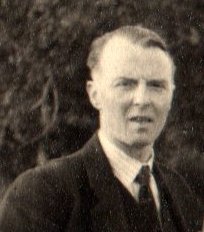
A manufactured textile cloth or material. Usually woven or knitted, also includes non-wovens, felts, laces and tufted cloths.
The side of a Fabric which is intended to be visible in its intended use.
A Loom which makes Carpet or Moquette as a 'sandwich' which is then slit apart to give two cloths, mirror images of each other. This type of loom is used for making all-cut Pile Fabrics, and is unable to manufacture loop-pile fabrics, which are made in a Wire-Loom.
The reduction in depth of Colour.
See Twisting.
 Fred Farrar, 1954
Fred Farrar, 1954Fred Farrar, Secretary of John Holdsworth & Company Limited, spinners and manufacturers of Shaw Lodge Mills, Halifax, became finance director in November 1956.
Fred had spent all his working life with the firm, and was a Fellow of the Chartered Institute of Secretaries. He had been a staunch ally of the Holdsworth family and the firm, in his role as a trustee, in which he had played an important part in ensuring the survival of the business.
At a meeting in January 1964, to which neither
Thomas Downey nor
Fred Farrar were invited, the other trustees iterated that it was in the best long-term interests of all concerned that the business should be sold.
Farrar told them he considered that 'the best advantage of the children lies in the future success of the Company'
Fred was a former member of Halifax Area Hospitals Management Committee and a past chairman of Halifax General Hospital House Committee, from which he resigned in 1962. He was a founder-member and trustee of Savile Close Short Stay Home, Halifax and secretary of its Finance Committee.
Fred Farrar died on 5 July 1968 at his residence, 'Strathmore', 10 Savile Park, Halifax aged 59 years, leaving his wife Hilda Victoria and sons David and Howard.
The edge of the woven cloth in the loom, marked by the last weft thread that is nearest to the
reed as the cloth is being woven.
This is the position to which the weft is pushed by the reed during
Beating-up.
The maintenance, cleaning and refurbishment of machines.
A general name for the raw material, such as cotton, flax, hemp, etc., typically capable of being spun into yarn as used in textile manufacture.
See the separate section on
fibres.
A single fibre of infinite length, such as silk or man-made fibre.
An alternative name for Weft.
A number of films, for Cinema and Television have been made with scenes in and around
Shaw Lodge Mills.
For more details see the page on
Halifax.
The various processes applied to textile materials after Weaving to achieve a desired effect.
The property of a material whereby the combustion is slowed, terminated or prevented. The definition is published in ISO 4880-1984.
Capable of burning with a flame under specified test conditions.
A place where warp ends are not Leased in the correct order.
A cloth that has no Pile, Tufts or loops.
1. To rest on the surface of any fluid.
2. A length of yarn on the surface of a woven
Fabric which runs in the
Warp direction over or under several
Picks.
Loose fibres which fly out into the air during processing, also known as Lint. (Lint in this case indicates fibres which need to be removed as waste, which should not be confused with Lint, the useful cotton fibres separated from the seed in the ginning process.)
To Fold is to Twist together two or more single yarns to form a folded yarn. e.g. two-fold yarn and three-fold yarn.
A frame (or Sheet or Colour) of yarn in the context of Jacquard Weaving is used to describe the way the yarn is selected for lifting in the pattern. For example, in a three frame fabric the Jacquard can select the colour in Frame 1, or 2 or 3. Because of the way the yarns are arranged in the Creel, with each colour forming a sheet of threads they are often called sheets.
|
©
2026
David W. Holdsworth |
|
Please send questions, updates, additions to: |